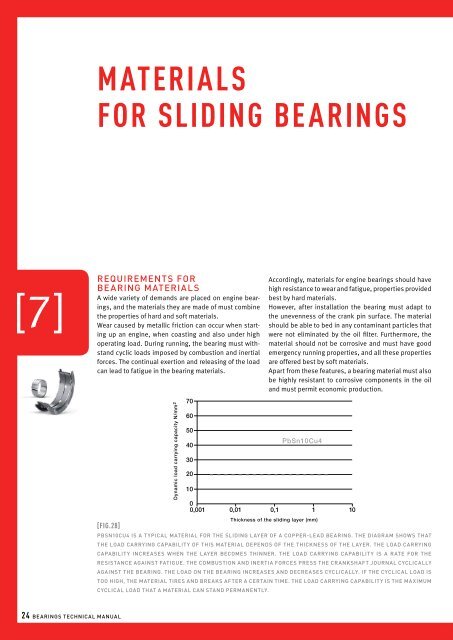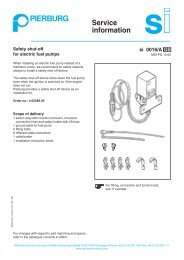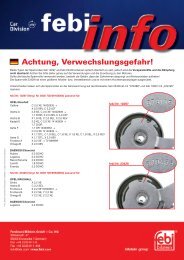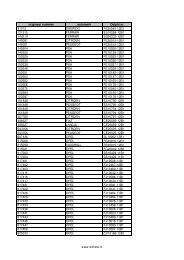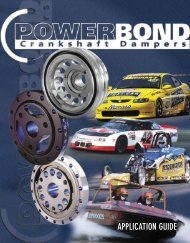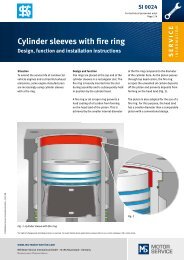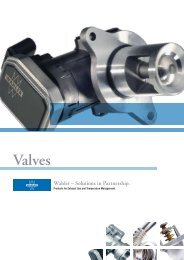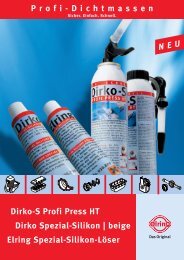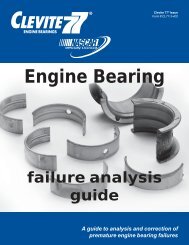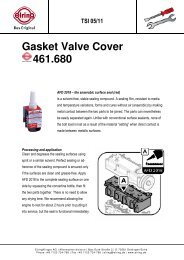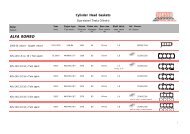EvEry bEaring you nEEd
EvEry bEaring you nEEd
EvEry bEaring you nEEd
You also want an ePaper? Increase the reach of your titles
YUMPU automatically turns print PDFs into web optimized ePapers that Google loves.
Materials<br />
for sliding bearings<br />
[7]<br />
Requirements for<br />
bearing materials<br />
A wide variety of demands are placed on engine bearings,<br />
and the materials they are made of must combine<br />
the properties of hard and soft materials.<br />
Wear caused by metallic friction can occur when starting<br />
up an engine, when coasting and also under high<br />
operating load. During running, the bearing must withstand<br />
cyclic loads imposed by combustion and inertial<br />
forces. The continual exertion and releasing of the load<br />
can lead to fatigue in the bearing materials.<br />
[fig.28]<br />
Dynamic load carrying capacity N/mm 2<br />
70<br />
60<br />
50<br />
40<br />
30<br />
20<br />
10<br />
Accordingly, materials for engine bearings should have<br />
high resistance to wear and fatigue, properties provided<br />
best by hard materials.<br />
However, after installation the bearing must adapt to<br />
the unevenness of the crank pin surface. The material<br />
should be able to bed in any contaminant particles that<br />
were not eliminated by the oil filter. Furthermore, the<br />
material should not be corrosive and must have good<br />
emergency running properties, and all these properties<br />
are offered best by soft materials.<br />
Apart from these features, a bearing material must also<br />
be highly resistant to corrosive components in the oil<br />
and must permit economic production.<br />
PbSn10Cu4<br />
0<br />
0,001 0,01 0,1 1 10<br />
Thickness of the sliding layer (mm)<br />
PbSn10Cu4 is a typical material for the sliding layer of a copper-lead bearing. The diagram shows that<br />
the load carrying capability of this material depends of the thickness of the layer. The load carrying<br />
capability increases when the layer becomes thinner. The load carrying capability is a rate for the<br />
resistance against fatigue. the combustion and inertia forces press the crankshaft journal cyclically<br />
against the bearing. The load on the bearing increases and decreases cyclically. If the cyclical load is<br />
too high, the material tires and breaks after a certain time. The load carrying capability is the maximum<br />
cyclical load that a material can stand permanently.<br />
Structure of bearing materials<br />
Composite materials offer the best chance of combining this<br />
range of contradictory requirements.<br />
Current composite materials generally have a steel spine as a<br />
basis. This basis gives the bearing shell or the bushing the necessary<br />
durability. During the production of the strip, this steel<br />
spine is coated with a layer of comparatively thin and soft bearing<br />
materials.<br />
This layer gives the bearing the necessary capability to carry high<br />
loads, increases the emergency running properties and enables<br />
the bedding-in of dirt particles.<br />
A further layer can increase the adaptation, embedding and<br />
emergency running properties more. This layer is produced after<br />
the bearing shell has been formed out of the strip. Means are<br />
electroplating or other processes (e.g. PVC Sputtering).<br />
Figure 28 shows how the fatigue resistance of a bearing’s layer<br />
depends on the thickness of the layer, increasing as the layer<br />
becomes thinner. By applying thin layers, the fatigue resistance<br />
of soft materials can be increased.<br />
Types of bearing materials<br />
In the early days of sliding bearing development, white metals<br />
were used for bearings. They contained lead and tin as base<br />
materials as well as cadmium or antimony as alloy materials.<br />
Today, however, two different types of materials are used most<br />
often. Composite materials of two and three layers have established<br />
themselves through practical experience (Figure 29).<br />
A two-layer (bi-metal) bearing is composed of a steel back and a<br />
bearing metal layer. This layer of bearing metal in modern bearings<br />
is a combination of aluminium, tin and some alloy materials<br />
like copper, anitmony or nickel. In the market, there are also combinations<br />
of aluminium with lead and tin. To achieve the desired<br />
material properties, various materials are combined and treated<br />
chemically or thermically.<br />
A three-layer or tri-metal bearing also uses a supporting steel<br />
back plus a bearing metal layer. This layer of bearing metal is<br />
generally made of leaded bronze. Like the tin and aluminium<br />
layer, it is between 0.2 and 0.3 mm thick. Higher performance<br />
bearings are made from either cast or sintered copper lead/<br />
leaded bronze. High to ultra high performances are catered for by<br />
varying the combination of elements that go into the materials,<br />
and by applying different overlay compositions as follows.<br />
This leaded bronze layer is then coated with an additional sliding<br />
layer made of a material still softer than leaded bronze and<br />
between 10 and 30 μm thick.<br />
In some cases the sliding layer and the bearing material are separated<br />
from each other by an intervening layer whose purpose is<br />
to prevent atoms from the bearing metal diffusing into the sliding<br />
layer. Diffusion processes can detract from the properties of the<br />
sliding layer.<br />
steel back<br />
2 layer version<br />
tin-aluminium layer<br />
steel back<br />
3 layer version<br />
lining material (bronze)<br />
sliding layer<br />
[fig.29]<br />
Conventional bearings are composed of two or three<br />
layers. The basis is always a back of steel. Either a layer<br />
of tin and aluminium or a layer of lead-bronze is bonded<br />
onto the steel back. The lead-bronze layer is plated<br />
with another layer. In the case of conventional bearings,<br />
this top layer is mainly composed of lead and tin.<br />
24 Bearings Technical Manual<br />
25


